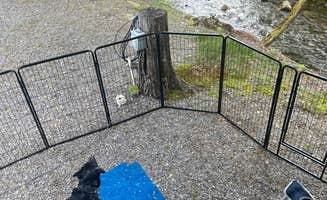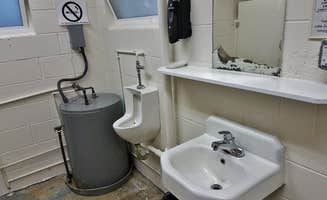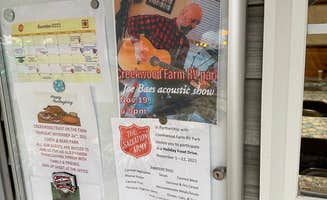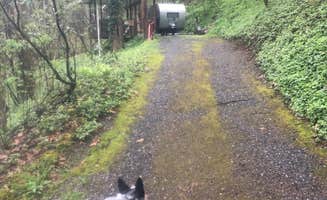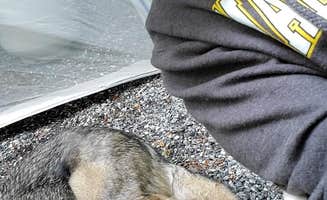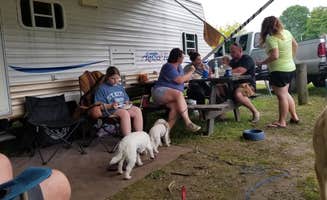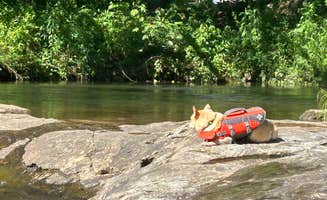The mountains surrounding Maggie Valley, North Carolina range from 3,000 to over 6,000 feet in elevation, creating distinct temperature zones that are typically 10-15 degrees cooler than nearby lowlands. This elevation difference makes the area popular for summer camping when lower elevations become uncomfortably hot. Winter camping is possible at some locations, though many campgrounds close seasonally from November through March.
What to do
Hiking near Mount Cammerer: Access multiple trails from Cosby Campground including the path to Mount Cammerer Fire Tower. "The AT is so close, love the Cammerer Fire Tower. Lovely old CCC log cabins. We saw bear tracks very close to the campground," reports Lynn G.
Fishing at stocked creeks: Many creeks in the area are regularly stocked with trout. "Jonathan Creek flows through the property, providing opportunities for pets to cool off during warmer months," while other campgrounds like Indian Creek offer fishing amenities. "The creek is stocked with trout, so bring your fishing gear!" advises Rich S.
Visit historic structures: Cataloochee Campground provides access to preserved mountain homesteads. "There are historical homesteads, a school, churches and cemetery to take you back in time. Trails by creeks there to hike," notes Jodie K., who recommends allowing time to explore these cultural sites.
What campers like
Creekside camping spots: Many campers specifically request sites along water features. At Moonshine Creek Campground, "The creek runs through the middle of the campground and can be heard from any site you are on," according to Nate C., making it popular for those seeking natural sound barriers.
Seasonal wildlife viewing: Elk sightings are common in certain areas during specific seasons. "If you want to see the elk, you're going to have to be up early. I use to be in the park at 5 AM with night vision gear, I saw some very nice elk," explains Patrick K. from Cataloochee, noting that winter offers daytime viewing opportunities.
Cooler temperatures at higher elevations: The mountain locations provide natural air conditioning. At Balsam Mountain Campground, "This time of year (end of July/beginning of August), the temps up there never get above 70 or 75, and the lows were in the low 50's," says Christina Z., making it ideal for summer camping.
What you should know
Road conditions vary significantly: Some campgrounds require navigating challenging roads. "Access to Cataloochee is via a narrow, winding, mountain road. A 3-mile stretch of gravel road contains many narrow, blind curves," explains Kristina, cautioning that large RVs might struggle on these routes.
Limited services at remote locations: Many campgrounds offer basic amenities only. "There is drinking water. No electricity, so if you need to charge your battery, you'll need to have a generator," notes Patrick K. about national park campgrounds.
Reservation requirements differ: While some locations fill quickly, others rarely reach capacity. At Smokemont Campground, "We stayed for one night, on a weeknight in early December. The campground was completely deserted (one other camper came in the evening, there were only two of us there!)," reports Carly E., highlighting off-season opportunities.
Tips for camping with families
Look for campgrounds with play areas: Some locations offer dedicated children's facilities. "They have a fenced dog park, great creek side sites and old, old, old growth trees at our site," mentions Jan H. about Stonebridge, while noting recent upgrades including "new concrete pads, upgraded bathrooms and game room."
Choose sites with water access for hot days: Creeks provide natural entertainment and cooling. At Indian Creek Campground, "The creek/river that runs through is amazing with most campsites sitting along one of the two creeks," says Abby L., making it ideal for families during warmer months.
Consider campgrounds with organized activities: Some locations provide scheduled entertainment. "There is a playground that had the kids excited, but it only consisted of a couple of baby swings," notes Nate C., but adds "The badminton/volleyball area was nice... The camp office had racquets and volleyballs to use."
Tips from RVers
Site positioning matters: At many campgrounds, RV sites have specific limitations. "The sites are close together, but as long as campers observe quiet hours (10 PM - 6 AM) and are aware that generators are allowed (60 dB max) to be run from 8 AM to 8 PM, all should be good," advises Robert W. at Balsam Mountain.
Check hook-up availability: Service levels vary significantly between campgrounds. At Creekwood Farm RV Park, "Many creek side spots. All are back in. 30,50 amp power, sewer and cable TV hookups. Reliable wi fi and good cell service," reports Harold W., noting this makes it suitable for longer stays.
Consider dog-friendly facilities: Many area campgrounds accommodate pets with specific amenities. "Great campground, fair amount of sites on creek, park like setting. Pull through sites for big rigs interior, full hookups include, cable, good wifi, good cell service," mentions Beverly T., making this location among the most dog friendly campgrounds near Maggie Valley.



